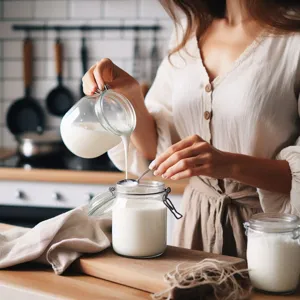There’s something truly magical about transforming simple ingredients into delicious homemade creations, and few culinary endeavors capture this essence quite like cheese-making.
Whether you’re a seasoned cook or a curious beginner, the journey from milk to masterpiece is both rewarding and surprisingly accessible. Imagine savoring the rich, creamy flavor of fresh mozzarella, the tangy bite of artisanal goat cheese, or the velvety texture of ricotta, all crafted by your own hands. In this blog post, we will explore the best ways to make homemade cheese, guiding you through the essential techniques, ingredients, and tips that will empower you to create your very own dairy delights. Get ready to embrace your inner cheese maker and elevate your culinary repertoire with these delightful recipes that promise to impress your family and friends!
1. Introduction to Homemade Cheese: Why You Should Try It

Making homemade cheese is more than just a culinary endeavor; it’s a rewarding journey that connects you to the art of food craftsmanship. Imagine transforming something as simple as milk into a luscious, creamy delight that tantalizes your taste buds and elevates your meals. Whether you’re a seasoned cook or a kitchen novice, crafting your own cheese opens up a world of flavors and textures that store-bought varieties simply can’t replicate.
One of the most compelling reasons to try your hand at cheese-making is the satisfaction of creating something uniquely yours. You’ll not only gain a deeper appreciation for the ingredients but also for the process itself. Each batch can be an experiment, a chance to play with flavors, and an opportunity to bring your culinary vision to life. Plus, homemade cheese can be tailored to suit your tastes—whether you prefer a sharp cheddar, a creamy ricotta, or a tangy goat cheese, the possibilities are limited only by your imagination.
Beyond the joy of creation, there’s also a practical aspect to consider. Making cheese at home can be a cost-effective alternative to purchasing artisanal cheeses, especially if you’re a cheese lover. You’ll find that the simple ingredients—milk, salt, and a few others—are often far less expensive than the gourmet varieties found in stores. Plus, you can control the quality of the ingredients, opting for organic or local options that align with your values.
Lastly, creating homemade cheese is a fantastic way to connect with family and friends. Picture a gathering where you proudly present a cheese board made from your own creations, complete with fresh fruits, nuts, and artisanal bread. The delight and intrigue on your guests’ faces as they taste your handiwork will make all the effort worthwhile.
So, if you’re ready to embark on a flavorful adventure, let’s dive into the world of homemade cheese. With a little guidance and a pinch of patience, you’ll soon be on your way to transforming humble milk into mouthwatering masterpieces.
2. Understanding the Basics
Before you embark on your cheese-making journey, it’s essential to grasp the foundational principles that underpin this age-old craft. Understanding the basics of cheese making involves recognizing the key ingredients, processes, and equipment required to transform simple milk into a delectable dairy delight.
At its core, cheese making revolves around just a few fundamental ingredients: milk, cultures, rennet, and salt. The type of milk you choose—be it cow, goat, or sheep—will significantly influence the flavor and texture of your final product. Whole milk is often recommended for beginners, as the higher fat content contributes to a creamier cheese.
Next, the role of cultures cannot be overstated. These are the bacteria that ferment the lactose in the milk, producing lactic acid, which is crucial for flavor development and the coagulation process. There are various types of cultures available, each lending its unique characteristics to the cheese. Whether you opt for mesophilic cultures for softer cheeses or thermophilic cultures for harder varieties, understanding their function will help you select the right ones for your desired outcome.
Rennet, an enzyme that helps coagulate the milk, is another essential component. It can be derived from animal, vegetable, or microbial sources, and using the appropriate type for your cheese will ensure proper curd formation. Finally, salt is not just a flavor enhancer; it also acts as a preservative, inhibiting unwanted bacterial growth and enhancing the cheese’s overall taste.
Equipping yourself with the right tools is equally important. A large pot for heating the milk, a thermometer to monitor temperature, a ladle for stirring, cheese molds for shaping, and fine cheesecloth for draining are the staples of a home cheesemaker’s toolkit. Investing in quality equipment will streamline your process and improve your results.
With a solid understanding of these basics, you’ll be well on your way to experimenting with different cheese varieties. Whether you’re dreaming of creamy ricotta, tangy goat cheese, or robust cheddar, mastering these foundational elements is the first step toward creating your own homemade cheese masterpiece. So gather your ingredients, equip yourself with knowledge, and get ready to turn the humble milk into something extraordinary!
3. Essential Tools and Equipment for Cheese Making

Embarking on the journey of homemade cheese-making can be both exciting and rewarding, but having the right tools and equipment is crucial for achieving that creamy, delectable end product. While cheese-making can be as simple or as intricate as you desire, here are the essential tools that every aspiring cheese artisan should consider having in their kitchen.
**1. Cheese Thermometer:** Precision is key when making cheese, and a good cheese thermometer will help you monitor milk temperatures accurately. Look for one that reads temperatures in both Fahrenheit and Celsius, with a range suitable for both heating milk and cooking curds.
**2. Large Stainless Steel Pot:** A heavy-bottomed stainless steel pot is ideal for heating milk evenly without scorching it. Choose a pot with a capacity that matches the quantity of cheese you intend to make, typically ranging from 2 to 8 quarts for home cheese-making.
**3. Long-Handled Spoon:** A sturdy, long-handled spoon is essential for stirring the milk as it heats and for gently mixing in ingredients like rennet and cultures. Opt for a spoon made from stainless steel or food-grade plastic to avoid any unwanted reactions with the ingredients.
**4. Cheese Mold and Press:** For hard cheeses, a cheese mold is necessary to shape and drain the curds. Molds come in various sizes and shapes, so consider the type of cheese you want to make. A cheese press is also a valuable tool to apply even pressure during the draining process, ensuring your cheese reaches the desired texture.
**5. Cheese Cloth:** A fine cheesecloth is vital for straining curds from whey and allows for easy drainage. Look for a durable, reusable option that can withstand repeated use and washing.
**6. pH Meter or Test Strips:** Monitoring acidity is important for some cheese varieties. A pH meter or test strips can help you track the curd’s acidity levels, ensuring optimal fermentation and flavor development.
**7. Preserving Jars or Cheese Storage Containers:** Once your cheese is made, proper storage is key to maintaining its quality. Invest in airtight containers or glass jars to keep your cheese fresh and ready for enjoyment.
Equipped with these essential tools, you’ll be well on your way to transforming humble milk into a delicious masterpiece. Each piece of equipment plays a crucial role in the cheese-making process, and understanding their functions will empower you to experiment and refine your techniques. So gather your tools, roll up your sleeves, and get ready to savor the delightful fruits of your labor!
4. Selecting the Right Milk for Your Cheese
Selecting the right milk for your cheese is arguably one of the most critical steps in the cheese-making process. The type of milk you choose not only influences the flavor and texture of the final product but can also dictate the overall success of your cheese-making journey.
When embarking on your homemade cheese adventure, consider the source of your milk. Cow, goat, and sheep milk each bring unique characteristics to the table. Cow milk, with its creamy texture and mild flavor, is an excellent choice for beginners, ideal for making soft cheeses like mozzarella or ricotta. Goat milk, on the other hand, offers a tangy zip and is perfect for creating deliciously distinct cheeses such as chèvre. If you’re feeling a bit more adventurous, sheep milk is rich and buttery, providing a luxurious base for cheeses like feta or pecorino.
Beyond the type of animal, the quality of milk is paramount. Fresh, high-quality, whole milk without additives or preservatives is essential for achieving the best results. If possible, seek out milk from local farms or markets that prioritize humane practices and do not use hormones or antibiotics. The fresher the milk, the more vibrant the flavors in your cheese will be.
Additionally, consider whether you want to use raw or pasteurized milk. While raw milk can yield cheeses with complex flavors, it also requires more advanced techniques and a thorough understanding of food safety. For beginners, pasteurized milk is often the safest and most accessible option, allowing you to focus on honing your cheese-making skills without additional concerns.
In summary, the milk you select is a foundational element that can elevate your cheese from good to extraordinary. Take the time to explore local options, and don’t hesitate to experiment with different types to discover the flavors and textures that resonate with your palate. Happy cheese-making!
5. The Science of Curdling: Acid vs. Rennet

In the world of cheese-making, understanding the science of curdling is crucial, as it forms the foundation of your cheese’s texture and flavor. At the heart of this process are two primary agents: acid and rennet. Each plays a distinct role in transforming liquid milk into the solid curds that will be the building blocks of your homemade cheese.
**Acid** is typically achieved through the addition of ingredients like lemon juice, vinegar, or cultured buttermilk. When you introduce acid to warm milk, the pH level drops, causing the proteins—primarily casein—to coagulate and form curds. This method is often used in fresh cheeses like ricotta and paneer, where a light, delicate texture is desired. Here, curdling occurs quickly, and the resulting cheese is usually mild and slightly tangy, perfect for salads or cooking.
On the other hand, **rennet** is a complex of enzymes traditionally sourced from the stomachs of ruminant animals, although vegetarian options are now available. When rennet is added to warm milk, it acts on the casein proteins, promoting a more gradual and thorough curdling process. This results in firmer curds with a richer flavor profile, making it ideal for cheeses like cheddar, mozzarella, or gouda. The use of rennet allows for a greater control over the texture and aging potential of the cheese, transforming it into a masterpiece that can develop complex flavors over time.
Understanding when to use acid versus rennet can elevate your cheese-making game. Experimenting with both methods will give you a deeper appreciation for the craft and help you create a variety of cheeses, each with its own unique character and taste. Whether you’re drawn to the quick satisfaction of an acid-set cheese or the intricate artistry of rennet-based varieties, mastering the science of curdling is your gateway to transforming simple milk into delicious homemade cheese.
6. Step-by-Step Guide to Making Fresh Cheese (e.g., Ricotta or Paneer)
Making fresh cheese at home is a rewarding and straightforward process that can elevate your culinary creations from ordinary to extraordinary. Whether you choose to make ricotta, paneer, or another variety, the basic steps remain largely the same. Here’s a step-by-step guide to help you craft your own delightful cheese.
### Ingredients You’ll Need:
– **Milk**: Use whole milk for the creamiest results. You can opt for cow’s, goat’s, or sheep’s milk based on your preference.
– **Acid**: Lemon juice or white vinegar works well to curdle the milk.
– **Salt**: For flavor, to taste.
### Step 1: Prepare Your Equipment
Before you begin, gather your utensils. You’ll need a large pot, a thermometer, a slotted spoon, cheesecloth or a clean dish towel, and a colander. Ensuring everything is clean will help prevent any unwanted bacteria from spoiling your cheese.
### Step 2: Heat the Milk
Pour your milk into the large pot and slowly heat it over medium heat. Stir gently to prevent scorching. Use your thermometer to monitor the temperature; you want to heat the milk to around 190°F (88°C). At this temperature, the milk will begin to froth and bubble, indicating that it’s ready for the next step.
### Step 3: Add the Acid
Once the milk reaches the desired temperature, remove it from heat and add your acid (lemon juice or vinegar). Stir gently for a few seconds, then allow the mixture to sit undisturbed for about 5-10 minutes. You’ll see curds forming as the milk separates from the whey.
### Step 4: Strain the Curds
Line your colander with cheesecloth or a clean dish towel and place it over a large bowl to catch the whey. Carefully ladle the curds into the colander, letting the whey drain away. If you prefer a drier cheese, let it drain for a bit longer.
### Step 5: Rinse and Season
Once the curds are well-drained, rinse them under cold water to remove the acidity from the vinegar or lemon juice. This step not only cools the curds but also helps to create a milder flavor. After rinsing, transfer the curds to a mixing bowl, sprinkle in salt to taste, and gently combine.
### Step 6: Shape and Store
At this stage, you can either leave the cheese loose for a rustic texture or shape it into balls or a block. If you’re making paneer, press the curds into a mold or wrap them in cheesecloth and place a weight on top to help them firm up. Once shaped, wrap your cheese tightly in plastic wrap or store it in an airtight container in the refrigerator.
### Enjoying Your Homemade Cheese
Whether you use it in a savory dish, as a topping for salads, or simply enjoy it fresh with a drizzle of olive oil and herbs, your homemade cheese will surely impress. The satisfaction of creating something so delightful from just a few simple ingredients is unparalleled. Plus, once you master the basic techniques, you can experiment with flavors and textures, making every batch uniquely yours. Happy cheesemaking!
7. Techniques for Aging Cheese: How to Create Unique Flavors

Aging cheese is both an art and a science, transforming humble curds into complex, flavor-packed masterpieces. The process of aging, or affinage, allows the cheese to develop its character, aroma, and taste, creating a unique profile that can range from nutty and buttery to sharp and tangy. Here are some techniques to harness the power of aging and elevate your homemade cheese experience.
1. **Temperature and Humidity Control**: The first step in successful aging is finding the right environment. Cheese thrives in cool, humid conditions. Ideally, aim for a temperature between 50°F and 55°F (10°C to 13°C) and a humidity level of around 85%. A dedicated cheese cave is perfect, but if that’s not available, a wine refrigerator or a simple cooler with a humidity source (like a damp sponge) can work wonders.
2. **Choosing the Right Rind**: The rind of the cheese is more than just a protective barrier; it plays a crucial role in flavor development. Soft cheeses, such as Brie, benefit from a bloomy rind that allows mold to flourish, imparting earthy tones. Hard cheeses, like Parmigiano-Reggiano, develop a firm, dry rind that protects the cheese while allowing for the enzymatic reactions that deepen flavors. Experimenting with different rind types can yield delightful variations in taste.
3. **Turning and Brushing**: Regularly turning your cheese wheels promotes even aging and prevents undesirable mold growth. For cheeses with a natural rind, gentle brushing with a cloth can help maintain surface cleanliness and encourage beneficial bacteria while removing any unwanted mold. Be consistent—turn your cheeses every few days to ensure they age evenly.
4. **Salting Techniques**: Salt is not just a flavor enhancer; it also acts as a natural preservative. The salting technique you choose will significantly impact the final flavor. Dry salting involves rubbing salt directly onto the cheese surface, while brining submerges the cheese in a saltwater solution. Experiment with different salt concentrations and methods to discover the perfect balance for your cheese type.
5. **Experimenting with Flavors**: Aging is the perfect time to infuse your cheeses with unique flavors. Consider adding herbs, spices, or even infused oils during the aging process. For example, a sprinkle of cracked black pepper can add a delightful kick, while fresh herbs like rosemary can impart a fragrant, earthy quality. As you age your cheese, don’t shy away from getting creative—this is where your culinary instincts can shine.
6. **Patience is Key**: While it may be tempting to sample your creations early, remember that great cheese takes time. The aging process can range from a few weeks to several months, depending on the type of cheese. Take notes throughout the journey, and don’t hesitate to make adjustments based on your observations. Each batch is an opportunity to learn and refine your techniques.
By embracing these aging techniques, you’ll unlock a world of flavors and textures, transforming your homemade cheese into a gourmet experience that friends and family will rave about. With a little patience and a dash of creativity, you’ll be well on your way to crafting cheese that not only delights your palate but also tells the unique story of your cheese-making journey.
8. Exploring Different Types of Cheese: A Brief Overview
When it comes to homemade cheese, the world is your oyster—or, in this case, your milk! Cheese-making is a delightful journey that opens up a realm of flavors and textures, each type offering its own unique character and culinary uses. Understanding the different types of cheese can inspire your cheese-making adventures and help you choose which ones to tackle first.
**Fresh Cheese:** This category includes soft cheeses like ricotta, mozzarella, and cream cheese. Fresh cheeses are typically made without aging, resulting in a mild flavor and creamy texture. They are incredibly versatile, perfect for spreading on toast, dolloping on pasta, or incorporating into salads. The process is often straightforward, making fresh cheese an excellent starting point for novice cheesemakers.
**Soft Cheese:** A step up from fresh cheese, soft cheeses like Brie and Camembert undergo a little aging but are still creamy and spreadable. These cheeses develop a lovely white rind, thanks to specific molds introduced during the aging process. Making soft cheese requires patience, as they need time to mature, but the reward is a rich and luscious treat that pairs beautifully with crusty bread and fruit.
**Semi-Hard Cheese:** Cheddar, Gouda, and Swiss fall into this category. These cheeses possess firmer textures and are aged longer than their soft counterparts, resulting in more complex flavors. The cheese-making process is slightly more involved, requiring careful monitoring of temperature and pH levels, but the outcome is well worth the effort. Aged semi-hard cheeses can be used in a variety of dishes, from melty grilled cheese sandwiches to savory cheese boards.
**Hard Cheese:** Parmesan and Pecorino are quintessential examples of hard cheeses. With their robust flavors and granular textures, hard cheeses are perfect for grating over pasta or salads. The aging process for these cheeses can take several months or even years, allowing them to develop deep, rich flavors. While making hard cheese is more intricate, the satisfaction of crafting a cheese that enhances your culinary creations is unparalleled.
**Blue Cheese:** For the adventurous cheesemaker, blue cheese offers a unique challenge. Characterized by its distinct blue veins of mold, varieties like Roquefort and Gorgonzola boast bold flavors that can be both tangy and creamy. The process involves inoculating the cheese with specific molds and allowing it to develop in a controlled environment. While blue cheese may require a bit more expertise, the resulting cheese is a true masterpiece.
Exploring these different types of cheese not only enhances your skill set but also broadens your culinary horizons. Each cheese has its own story and potential, waiting for you to uncover in your kitchen. Whether you’re creating a simple ricotta or embarking on the intricate journey of making a blue cheese, the experience is sure to enrich your appreciation for this amazing dairy delight. So grab your milk and let your cheese-making adventure begin!
9. Flavoring Your Cheese: Herbs, Spices, and Other Additions
Flavoring your cheese is where the magic truly happens, transforming a simple block of white curds into a delectable work of art that tantalizes the taste buds. The possibilities are virtually endless, and experimenting with different herbs, spices, and other additions can elevate your homemade cheese to restaurant-quality indulgence.
Start with the classics. Fresh herbs like basil, chives, or dill can be chopped and folded into your curds, imparting a vibrant freshness that adds a delightful twist to your cheese. Alternatively, dried herbs such as oregano or thyme can provide a more concentrated flavor that develops beautifully as the cheese ages. For an aromatic boost, consider seasoning your cheese with crushed garlic or a sprinkle of onion powder, creating a savory depth that pairs wonderfully with crusty bread or crackers.
Spices also play a crucial role in flavoring your cheese. A pinch of smoked paprika can lend a subtle smokiness, while crushed red pepper flakes add just the right amount of heat for those with a bold palate. For a distinctly Mediterranean flair, try adding za’atar, a fragrant blend of thyme, sesame seeds, and sumac that will transport your taste buds to sun-soaked shores.
Don’t overlook the potential of sweet additions, either! A touch of honey or a swirl of maple syrup can create an intriguing contrast in a creamy cheese, while fruits like figs, cranberries, or even sun-dried tomatoes can introduce a sweet-tart balance. Experimenting with nuts, such as finely chopped walnuts or pistachios, can add a satisfying crunch and nuttiness to your cheese, making it even more enticing.
As you play with flavors, keep in mind that less is often more. Start with small amounts of your chosen ingredients and taste as you go, allowing the natural cheese flavors to come through while enhancing them with your flavorful additions. Whether you prefer a herby spreadable cheese, a zesty pepper-infused cheese, or a sweet and nutty creation, the key is to have fun and let your creativity shine. With each batch, you’ll not only refine your cheese-making skills but also develop a unique flavor profile that reflects your personal tastes, ensuring that your homemade cheese is always a masterpiece.
10. Common Mistakes to Avoid
Making cheese at home can be a rewarding and delicious endeavor, but it’s not without its challenges. Even seasoned home cheesemakers can find themselves tripped up by a few common missteps. Here are some pitfalls to watch out for to ensure your cheese-making experience yields the best results.
**1. Skipping the Sanitization Process:**
One of the most crucial steps in cheese-making is ensuring that all your equipment is impeccably clean. Bacteria and unwanted microorganisms can easily spoil your milk and ruin your cheese. Always sanitize your utensils, molds, and surfaces before you start, and avoid touching anything that isn’t clean during the process.
**2. Using the Wrong Milk:**
Not all milk is created equal when it comes to cheese-making. While whole milk is often ideal, be wary of ultra-pasteurized milk, which can prevent your rennet from coagulating the milk properly. Opt for fresh, raw, or pasteurized milk from a reliable source for best results.
**3. Ignoring Temperature Control:**
Temperature plays a critical role in cheese-making. Too high or too low temperatures can affect the curd formation and texture of your cheese. Invest in a reliable thermometer and keep a close eye on the temperature at every stage, especially during heating and culturing.
**4. Rushing the Curd Cutting Process:**
Cutting the curds too soon or too late can drastically alter your cheese’s texture. Allowing the curds to set for the appropriate time is essential for achieving the right consistency. Follow your recipe closely and be patient; good things come to those who wait!
**5. Over- or Under-salting:**
Salt is not just for flavor; it also helps with preservation and affects the cheese’s texture and moisture. Too much salt can overpower the flavor, while too little can lead to spoilage. Be precise with your measurements and taste as you go.
**6. Neglecting to Age Properly:**
Aging is where the magic happens for many cheeses, contributing to their flavor and texture. Avoid the mistake of rushing this process. Ensure you have a suitable aging environment—cool, dark, and humid—and be patient as your cheese develops its character.
By steering clear of these common mistakes, you’ll be well on your way to crafting delicious homemade cheese that you can be proud of. Embrace the learning curve, and remember that even the occasional mishap can lead to valuable lessons and, perhaps, unexpectedly delightful flavors!
11. Storing and Preserving Your Homemade Cheese
Storing and preserving your homemade cheese is just as crucial as the crafting process itself. Once you’ve put in the time and effort to create your cheesy masterpiece, ensuring it stays fresh and flavorful is essential to enjoying it for weeks or even months to come. The right storage techniques can significantly extend the shelf life of your cheese while maintaining its delightful taste and texture.
First and foremost, consider the type of cheese you’ve made. Soft cheeses, like ricotta and cream cheese, have a higher moisture content and should be stored in an airtight container in the refrigerator. This will help prevent them from drying out and picking up unwanted odors from the fridge. Make sure to consume these cheeses within a week or two for optimal freshness.
On the other hand, harder cheeses, such as cheddar or gouda, can be wrapped in parchment paper or cheese paper, which allows them to breathe while preventing them from drying out. After wrapping, place the cheese in a breathable container or a cheese dome to further protect it from moisture loss. Hard cheeses can often last for several weeks in the fridge, but be sure to check for signs of mold or spoilage regularly.
For longer-term storage, you might consider freezing your cheese. However, not all cheeses freeze well. Hard cheeses generally hold up better when frozen, while soft cheeses may become crumbly after thawing. To freeze cheese, cut it into manageable portions and wrap it tightly in plastic wrap, followed by aluminum foil to prevent freezer burn. You can also vacuum seal your cheese for the best preservation results. Just remember to label your packages with the date and type of cheese to keep track of your stash.
Lastly, don’t overlook the importance of proper aging for certain types of cheese. If you’re crafting a cheese that benefits from aging, like a blue cheese or aged cheddar, be sure to monitor the temperature and humidity levels in your aging environment. A dedicated cheese cave or a controlled space in your refrigerator can create the ideal conditions for your cheese to develop its full flavor potential.
By mastering the art of storing and preserving your homemade cheese, you can ensure that your delicious creations remain enjoyable for as long as possible, ready to be savored on your favorite charcuterie board or melted into your next culinary masterpiece.
12. Pairing Homemade Cheese with Food and Wine
Pairing homemade cheese with food and wine can elevate your culinary experience from delightful to extraordinary. The beauty of crafting your own cheese is that it allows you to explore a world of flavors, textures, and aromas that store-bought varieties simply can’t match. Once you’ve mastered the art of cheese-making, the next step is to discover how to complement your creations with the right accompaniments.
Start with the basics: fresh cheeses like ricotta or mozzarella. These mild varieties shine when paired with fresh fruits and herbs. Imagine a creamy dollop of homemade ricotta atop a warm slice of rustic bread, drizzled with honey and sprinkled with sea salt. Add a handful of fresh figs or berries, and you’ve got a dish that sings with seasonal vibrancy. For mozzarella, a classic caprese salad—layered with ripe tomatoes, fragrant basil, and a splash of balsamic glaze—showcases the cheese’s delicate flavor beautifully.
As you venture into aged cheeses like cheddar or gouda, consider pairing them with hearty accompaniments. A sharp cheddar pairs wonderfully with crisp apples or pears, while aged gouda, with its nutty undertones, complements rich meats like prosciutto or salami. A charcuterie board featuring your homemade cheeses, artisan meats, and a variety of pickles and olives can become a stunning centerpiece at any gathering.
When it comes to wine, the right pairing can truly enhance the tasting experience. Fresh cheeses generally pair well with light, crisp whites such as Sauvignon Blanc or Pinot Grigio, which balance the creaminess without overpowering it. For aged cheeses, consider a bold red like Cabernet Sauvignon or a rich Chardonnay that can stand up to the deeper flavors. Don’t forget to experiment with sparkling wines, as their effervescence can cut through the richness of cheese, providing a refreshing contrast.
Ultimately, the art of pairing is about personal preference. Invite friends and family to join in the exploration, creating a festive atmosphere where everyone can share their thoughts on the delightful combinations. With your homemade cheese as the star of the show, the possibilities for delicious pairings are endless, making every meal a memorable celebration of flavor.
13. Creative Ways to Use Your Cheese in Recipes
Once you’ve mastered the art of cheese-making, the culinary adventure doesn’t end there! Homemade cheese presents a world of possibilities, allowing you to elevate your everyday meals and impress your friends and family. Here are some creative ways to incorporate your artisanal creations into delicious recipes that celebrate your handiwork.
**1. Creamy Cheese Spreads:** Blend your soft cheeses, such as ricotta or cream cheese, with herbs, spices, and perhaps a touch of honey for a delightful spread. Serve it on crusty bread or crackers as a part of an appetizer platter. You can experiment with flavors—think sun-dried tomatoes and basil or garlic and chive—to suit your palate.
**2. Gourmet Mac and Cheese:** Take your homemade cheese to the next level in a classic comfort dish. Mix a medley of your cheeses—sharp cheddar, creamy mozzarella, or a tangy goat cheese—with cooked pasta and a splash of cream. Top it with breadcrumbs and bake until golden for an indulgent treat that will have everyone asking for seconds.
**3. Cheese-Stuffed Vegetables:** Hollow out bell peppers, zucchini, or tomatoes and fill them with a savory mixture of your cheeses, grains, and spices. Bake until the vegetables are tender and the cheese is bubbling for a colorful and nutritious main course or side dish.
**4. Homemade Pizza:** Nothing beats the taste of freshly made pizza topped with your own cheese. Use mozzarella or a blend of cheeses, along with your favorite toppings. Bake in a hot oven for a crispy crust and gooey, melty cheese that will make pizza night a feast to remember.
**5. Salads with Flair:** Crumble your homemade feta or goat cheese over fresh salads to add a creamy texture and flavor contrast. Pair it with seasonal vegetables, nuts, and a light vinaigrette for a refreshing and satisfying dish.
**6. Cheese Desserts:** Yes, cheese can be part of your dessert repertoire too! Use mascarpone or ricotta to create light and airy desserts like cheesecakes, tiramisu, or layered parfaits. The natural sweetness of the cheese pairs beautifully with fruits and honey, perfect for a sweet ending to any meal.
By thinking outside the box and exploring these creative culinary uses for your homemade cheese, you can turn your kitchen into a gourmet paradise. Each dish not only showcases your cheese-making skills but also invites others to savor the delicious flavors and textures that only homemade cheese can provide. Enjoy the delightful journey from milk to masterpiece, one delicious recipe at a time!
14. Troubleshooting Common Cheese-Making Problems
Making cheese at home can be a rewarding and creative endeavor, but it’s not without its challenges. Even the most experienced cheesemakers encounter hiccups along the way. Understanding how to troubleshoot common cheese-making problems can save your batch and enhance your skills.
One frequent issue is curd separation, where the curds and whey don’t fully separate as expected. This can often be traced back to temperature inconsistencies. Ensure you’re maintaining the right temperature throughout the process; investing in a reliable thermometer can make a world of difference. If you find yourself with curds that are too dry, try a gentler heating method or reduce the acidification time in your recipe.
Another common problem is unwanted flavors or odors in the finished cheese, which may arise from improper sanitation or contamination. Always ensure your equipment is meticulously cleaned and sanitized before starting, as even the smallest residue can affect the taste of your cheese. If you notice bitterness, it could be due to overcooking your curds or using poor-quality milk, so be mindful of your ingredients and cooking times.
Texture issues can also arise, with cheese turning out grainy or crumbly instead of smooth and creamy. This could be the result of too much acid or not enough fat in your milk. When experimenting with different types of milk, remember that higher fat content typically leads to creamier cheeses. Lastly, if your cheese isn’t aging properly or developing the desired flavor profile, consider adjusting your aging conditions—humidity and temperature play crucial roles in the maturation process.
By keeping an eye on these potential pitfalls and being ready to adapt, you’ll not only salvage your current batch but also gain invaluable insights for your next cheese-making adventure. Remember, each mistake is a stepping stone toward mastery, turning your initial frustrations into flavorful triumphs!
15. Conclusion: The Joy of Making Cheese at Home
In conclusion, the journey of making cheese at home is not just a culinary venture; it’s a delightful experience that transforms the humble ingredients of milk and culture into a delicious masterpiece. The process may seem daunting at first, but with each step, you’ll discover the joy that comes from creating something uniquely your own. From the pristine moment of curdling milk to the satisfaction of crafting your favorite varieties—be it creamy ricotta, tangy feta, or robust aged cheddar—the rewards are truly unparalleled.
Homemade cheese offers an intimate connection to your food, allowing you to experiment with flavors and textures that store-bought varieties simply can’t match. Each batch you make becomes a testament to your growing skills and creativity in the kitchen. Imagine sharing a platter of your homemade cheese with friends and family, savoring the pride that comes from serving something crafted by your own hands.
As you embark on this cheesy adventure, remember that the journey is just as important as the destination. Whether you’re perfecting the art of mozzarella or venturing into the world of blue cheese, embrace the learning process, celebrate your successes, and don’t shy away from the occasional mishap—each mistake is a stepping stone toward mastering this timeless craft.
So, gather your ingredients, roll up your sleeves, and dive into the world of cheese-making. The joy of creating delectable cheese at home is waiting for you, and with each bite, you’ll savor not just the flavor, but the fulfillment that comes from bringing a little piece of culinary magic into your kitchen. Happy cheese making!









